AMD’s high-end Ryzen CPUs on the AM5 platform have been dominating with CPUs like the Ryzen 9 9950X and 9950X3D both being monsters. That said, it isn’t actually the top of AMD's product lineup, they do still have their Threadripper lineup. They launched their Threadripper and Threadripper Pro 7000 Series of CPUs in late 2023, including a new sTR5 socket and TRX50 and WRX90 chipsets, and they are back at it again with their new 9000 Series of Threadripper CPUs that hit stores tomorrow. Ahead of that launch, I have had the top two CPUs in the office on the bench, the Ryzen Threadripper 9980X and 9970X, and today we can check out how they performed.
Product Name: AMD Threadripper 9980X and 9970X
Review Sample Provided by: AMD
Written by: Wes Compton
Amazon Affiliate Links:
9000 Series Threadripper?
AMD's latest generation of Threadripper CPUs formally went under the name Shimada Peak and is now the 9000 Series. These drop in between the mainstream Ryzen CPUs and the recently introduced Threadripper PRO WX Series of CPUs. These are focused on the HEDT or High End Desktop market, namely for enthusiasts, creators, and pro users who don’t need the extra pro features or the octa-channel memory that you can get with the WX-Series of CPUs. The new 9000 Series updates the Threadripper line with Zen 5 when compared to the previous Threadripper 7000 Series.






So what CPUs did they announce for the Threadripper 9000 Series? There are just three CPUs, and those all line up with the three CPUs from the previous 7000 Series. There are the Threadripper 9980X, 9970X, and 9960X. AMD sent over two of those three for testing today. But the way they break down is the 9980X is the new non-Pro flagship, and like the 7980X before it, it has 64 cores and 128 threads. In addition to the changes with the Zen 5 architecture, it has also increased the max boost frequency from up to 5.1 GHz up to 5.4 GHz. They have the same base clock at 3.2 GHz, and both L2 and L3 cache are still the same. The max non-OC memory speeds have increased from DDR5-5200 up to DDR5-6400, which is a huge increase. The Threadripper 9970X is like the 7970X with 32 cores and 64 threads, and like with the 9980X, it also has an increase in max boost frequency, this time from 5.3 GHz up to 5.4 GHz, and it also has the new faster non-OC memory speed support. Then the last CPU, the 9960X, matches up with the 7960X with 24 cores and 48 threads, and it has the same faster max boost and non-OC memory speed increases. One thing to note is that the base clock frequencies do increase as we drop down through the product stack. All of the new 9000 Series CPUs have 90 PCIe 5.0 lanes to the 48 lanes from the 7000 Series CPUs, but beyond that, they all share the same sTR5 socket, TDPs, and max current as well. The new CPUs are positioned in the same launch MSRPs as the previous generation, which puts the Threadripper 9980X at $4999, the 9970X at $2499, and the 9960X at $1499. All three prices will seem very high when compared to the Ryzen mainstream lineup, the 9950X3D, for example, launched at $699. But for someone looking at their options from the Threadripper Pro lineup, they look a lot more affordable. The Threadripper Pro 9965WX with 24 cores is $2899 to the $1499 of the 9960X here for example. The 9975WX with 32 cores is $4099 to the $2499 of the 9970X, and the Threadripper 9985WX is $7999 to the $4999 of the 9980X. There isn’t a 9000 Series CPU that matches up with the flagship Threadripper Pro 9995WX with its 96 cores, however.

AMD did send over a full setup for testing both of the CPUs and I wanted to make sure to show what we will be testing with. You can see the full list in the next section, but their test configuration came with a Crucial T705 1TB Gen 5 SSD. It isn’t an ultra-high capacity, but speed-wise wise it is a good match for the Threadripper CPUs.




For memory, they went all out with G.Skill's help. The kit they sent over is the G.Skill T5 Neo Series DDR5-6400 R-DIMM Memory Kit, which is a quad-channel 128GB kit running at 6400 MHz. They don’t have any heatspreaders but do have blacked out PCBs.






For the motherboard, AMD's kits could come with one of two motherboards, and our kit came with an Asus Pro WS TRX50-SAGE Wifi, one of three TRX50 boards that Asus has in their lineup. There is WAY too much going on with the board to touch on everything here, but I did want to show off the large heatsinks in three of the four sides of the huge sTR5 socket. It supports single or dual power supply configurations, which can be very important when you have a CPU pulling the power that these can pull on top of one or multiple GPUs.







Last up, all of that power creates a lot of heat. To keep things cool, they also sent over a Silverstone XE360-TR5 cooler. I haven’t built anything Threadripper for a while, and the size of the surface area for the cooler is always shocking when you are used to seeing coolers for AM5 CPUs. This cooler has the pump built into the radiator, so the water block end of the cooler looks a lot like a custom cooler with the large water block.






Of course, we received the 9980X and the 9970X Ryzen Threadripper CPUs as well, and I can’t skip over those. Each CPU comes in its black and grey box with orange trim, just like any Ryzen CPU, and at a quick glance, these boxes aren’t really much different than any normal Ryzen CPU that comes with an air cooler. Only these don’t have an air cooler. Inside the box, you have a thick foam insert that cradles the CPU, which comes in its own plastic clamshell on one side of the foam. Under that, you get a certificate of authenticity, which has the warranty and installation instructions. Along with that, you also get a cool AMD Threadripper case sticker as well. Then, around on the back of the foam, there are two components. You have the installation tool, which you will need to install the CPU into any sTR5 socket. Then, along with that is an adapter for Asetek coolers with their standard round mounting solution. This means that it is possible that you don’t need to get a Threadripper exclusive cooling solution, you may have a cooler that would already work. That said, the contact surface with those coolers is much smaller, so while it will work, it’s still not optimal.





I’ve said it already, but these are huge. Pictures don’t do them justice until you get one sitting next to an AM5 CPU, like in the pictures below. Like with all past Threadripper CPUs and other server CPUs, both the 9980X and 9970X come with an orange carrier frame already attached to help simplify installation. Neither of the CPUs looks any different from the other on the front or back, other than the branding. Like with all Ryzen CPUs, AMD has etched a large logo across the top of the heatspreader and then the model name below that. In the bottom half, you have a QR code with more detailed information like its serial number, its batch, and where it was manufactured. Of course, with the huge CPU size, it is all spread out, not packed in like on an AM5 CPU.






Where a standard CPU just has one clip and a basic cover on the CPU socket, to install these, you need the included tool, and there are a few extra steps. AMD has made it simple with each of the bolts being numbered, so you can use the tool to open up the CPU socket. Once open, you can remove the plastic insert that protects the socket. Then we want to also remove the plastic insert in the CPU tray. That is where you will slide the CPU with its carriage frame in. Once all the way down, you can latch the CPU down with the two small clips. Then the main bracket drops down, and you use the included tool to tighten each of the three screws down. The tool gives way when you reach the correct torque. While more complicated, it leaves less room for error, and I think inexperienced users might find something similar to this with the mainstream platform to be easier.






Before getting into testing, I ran CPUz just to confirm everything was good to go.



Test Rig and Procedures
Test Rig
Motherboard – Asus Pro WS TRX50-SAGE WIFI
Ram – G.Skill F5-6400R3239F32GQ4-T5N 128GB T5 Neo Series DDR5-6400 R-DIMM Memory Kit
Storage – Crucial T705 1TB Gen5 NVME M.2 SSD
Video Card – Nvidia RTX 4090 Founders Edition
OS - Windows 11 Pro
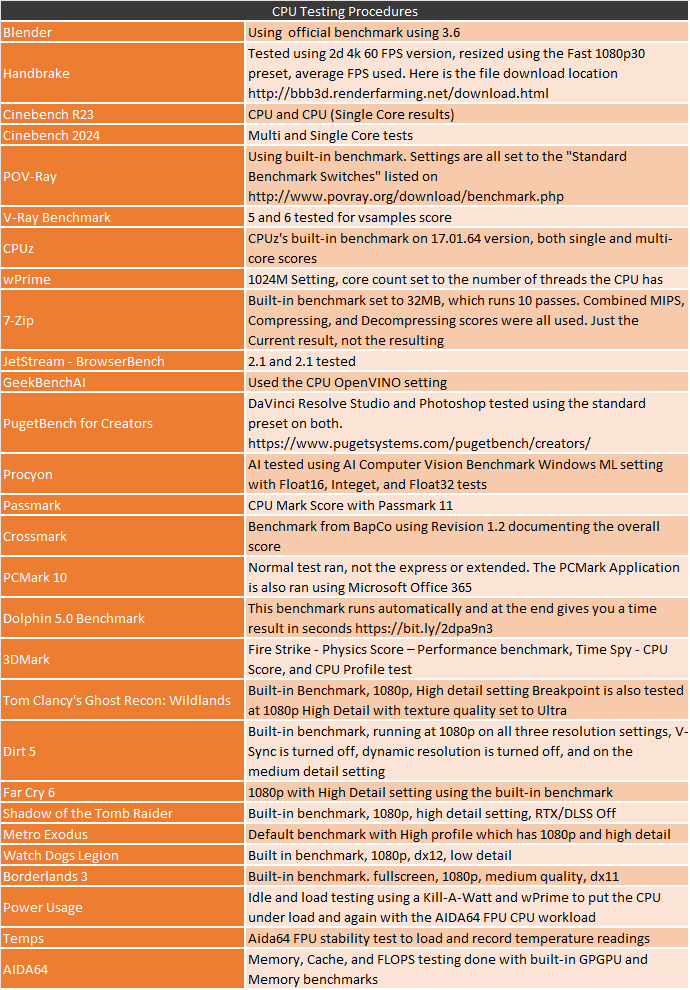
CPU Performance
To start off our testing, I went with the rendering-focused Blender benchmark. To get a good look at the overall performance, I have all three of the results stacked together, and in this test, both the Threadripper 9980X and the 9970X completely dominate the results. The Ryzen 9950X3D topped our chart previously by a good margin, but the 9980X has the combined result covered with just the result from ONE of its tests.

Continuing with the video encoding theme, I also have Handbrake, which is an open-source transcoder. For this test, I am taking a 4k video down to 1080p 30 FPS, and the results are the average FPS of that task. The results here are a little more interesting, but it does highlight an issue you start to see with some software. The Threadripper 9970X is the CPU at the top of the chart here, not the 9980X. Handbrake scales well up to 6 cores and then sees diminishing returns as it goes up from there. With the 9970X having a higher base clock speed, it pushes it up past the 9980X as well as the 285K.
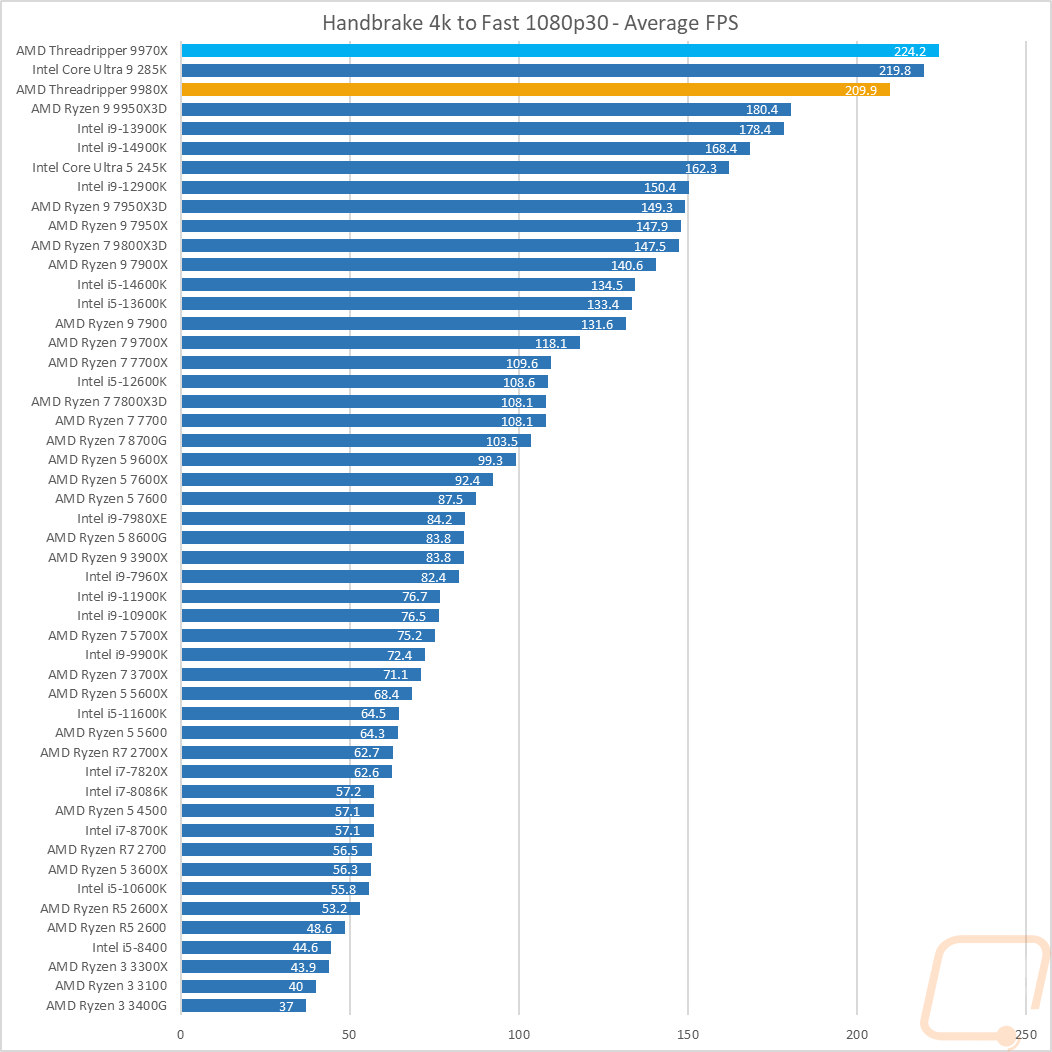
For the always popular Cinebench, I am testing with the older Cinebench R23 as well as the newer 2024 edition as well. I always like Cinebench because we have multi-core and single-core performance, which gives us a good look at the performance of the whole CPU and IPC performance. In R32, both of the Threadripper CPUs dwarf the other CPUs tested, with the 9980X way out in front with an impressive multi-threaded score of 114,621, almost three times the score of the Ryzen 9 9950X3D, which is impressive in its own right. The 9970X scored 76170, which is almost double the 9950X3D. For single-core performance, both the 9970X and 9980X are just slightly behind, however. The Cinebench 2024 results were similar as well, with a multi-threaded score of 6604 for the 9980X and 4174 for the 9970X, again making everything else tested look slow in comparison.
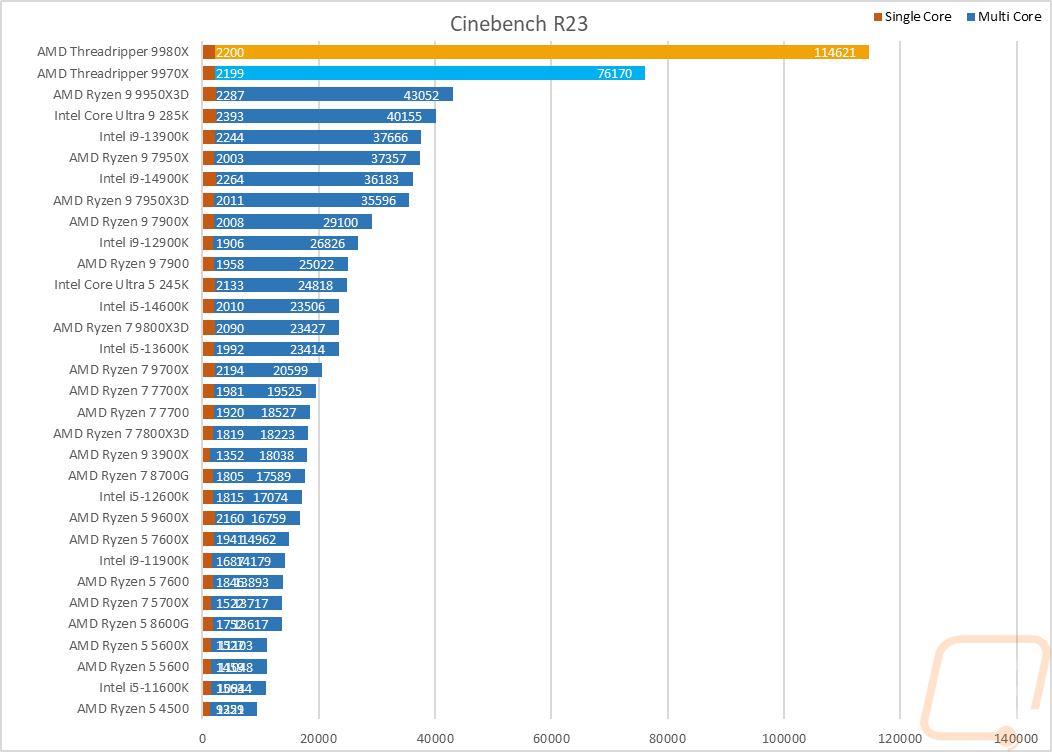
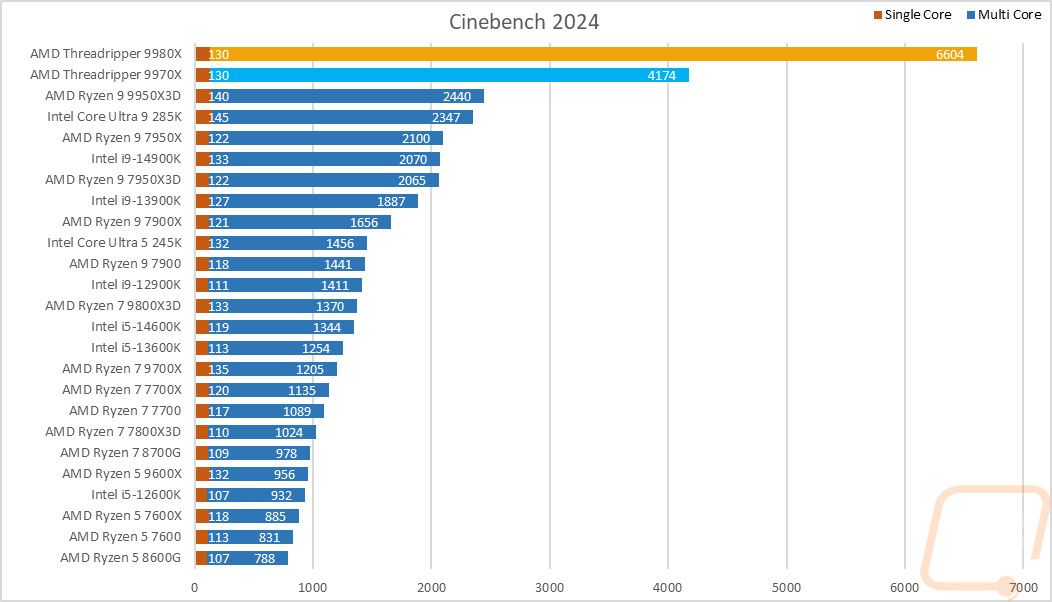
Next up, we have ray tracing-focused rendering benchmarks. Here I tested the CPUs in POV-Ray and V-Ray Benchmark 5. POV-Ray was also tested with a single core and across all of the cores. The Threadripper 9980X and 9970X both sit way out in front in POV-Ray with scores of 23896 and 22550, with the next highest score being the Intel Core Ultra 9 285K at 14424 when testing Multi-Core. Single-core results have them sitting a little lower than the mainstream line CPUs with higher clock speeds. The 9980X scored a 797.55 and the 9970X a 794.11. For V-Ray Benchmark 5, both 9000 Series CPUs take off once again, with the 9980X scoring almost 100k with its 97551 score and 60574 for the 9970X, two and three times the 34211 of the 9950X3D.
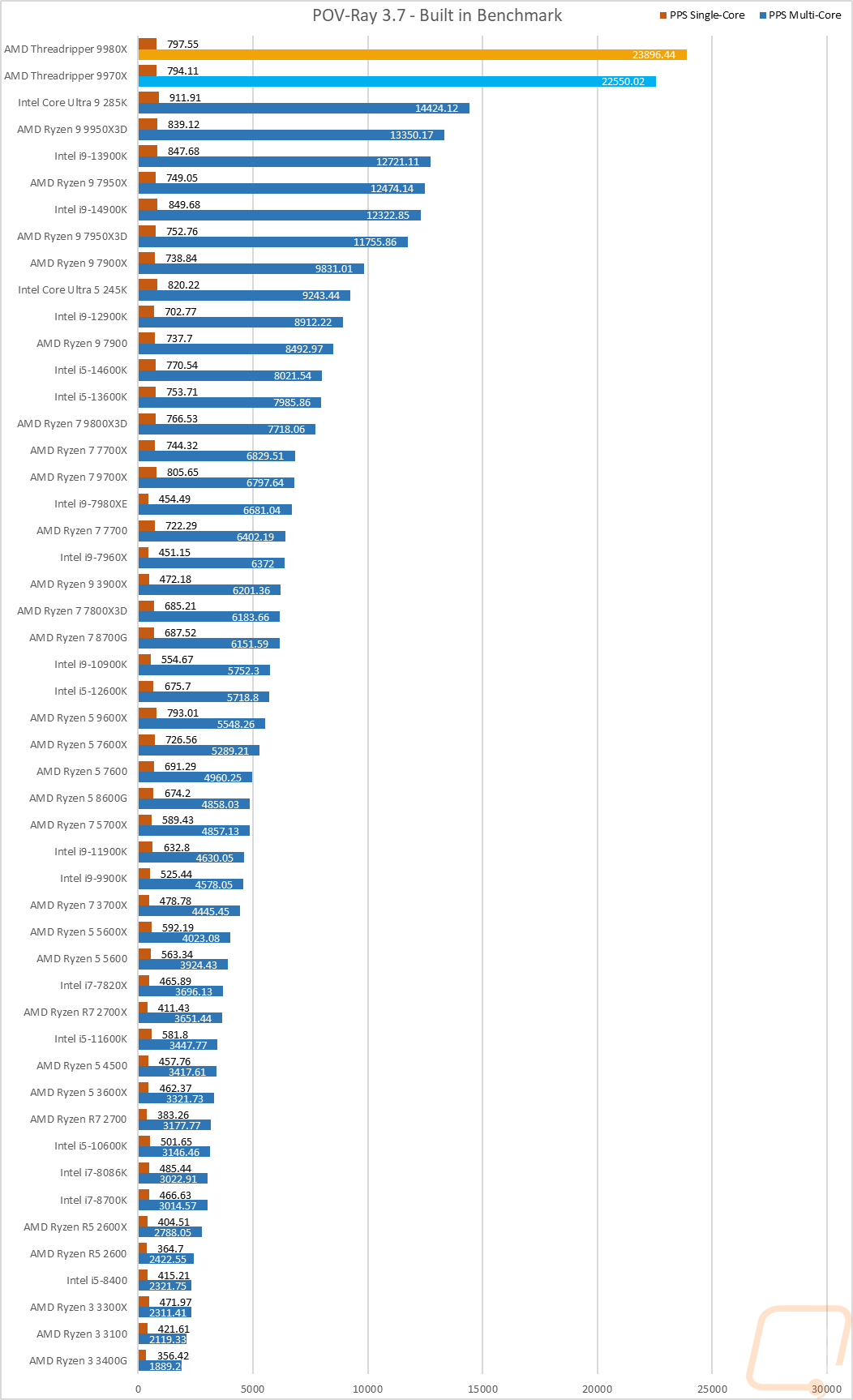
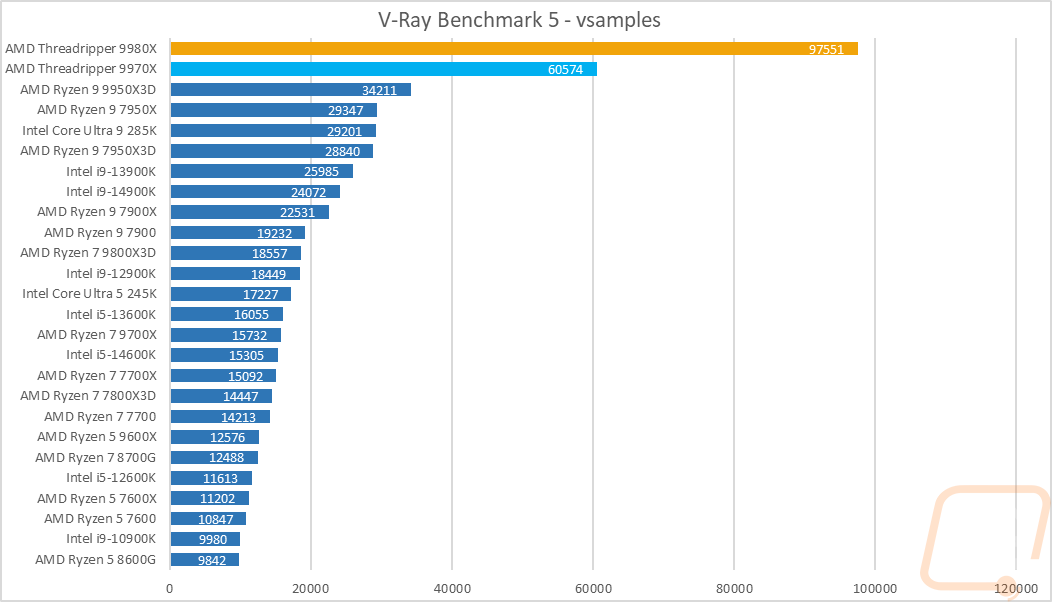
I also tested using CPUz’s built-in benchmark, which runs on a single thread and with all threads. In the single-thread test, you can see how the lower max and core clock speeds of both CPUs keep them behind the top few CPUs from Intel and AMD's mainstream lineups. With the multi-threaded test, however, they have legs. The Threadripper 9980X scored an impressive 56499, and the 9970X scored 32613, both making the 285K look slow with its 18504.
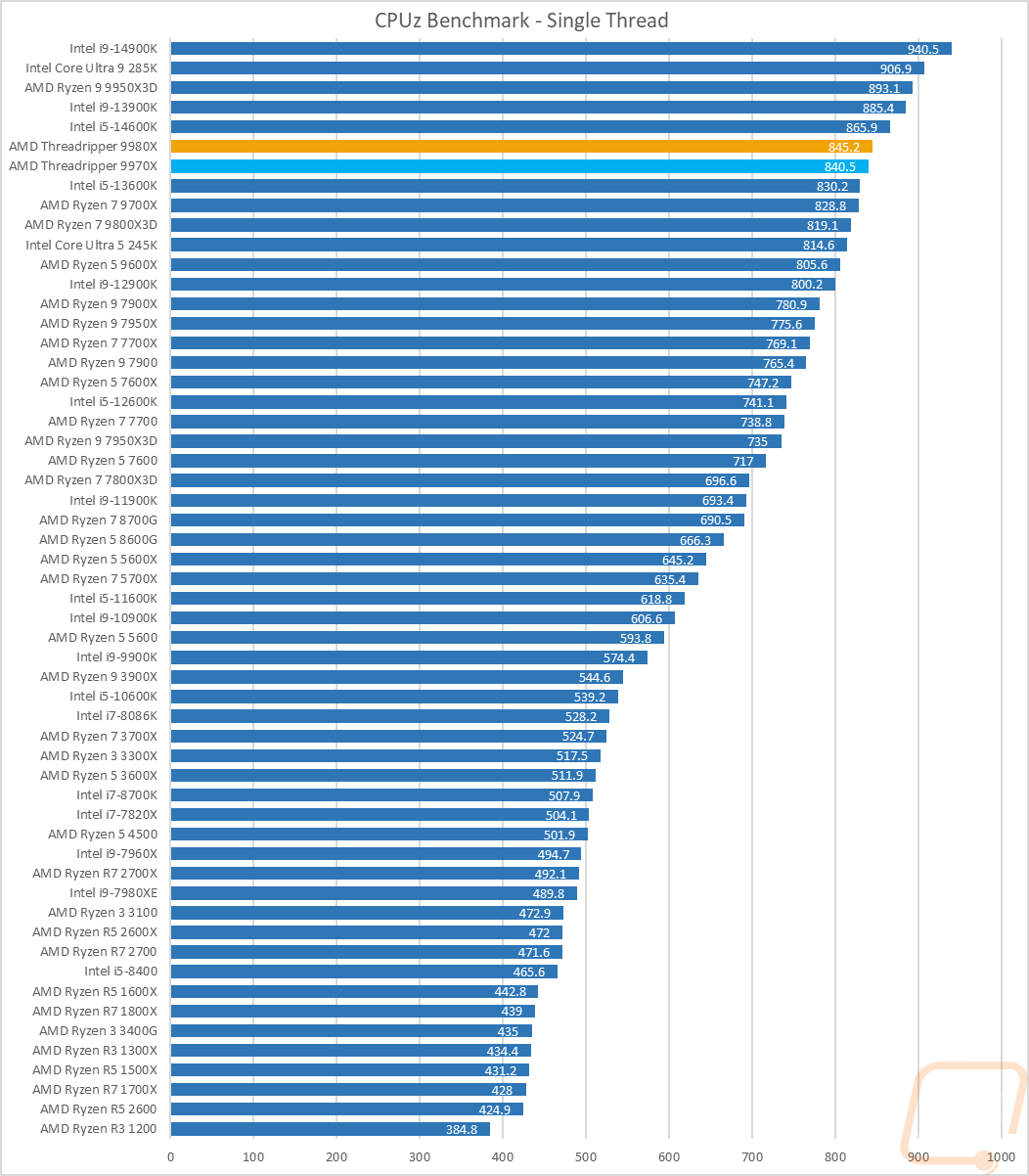
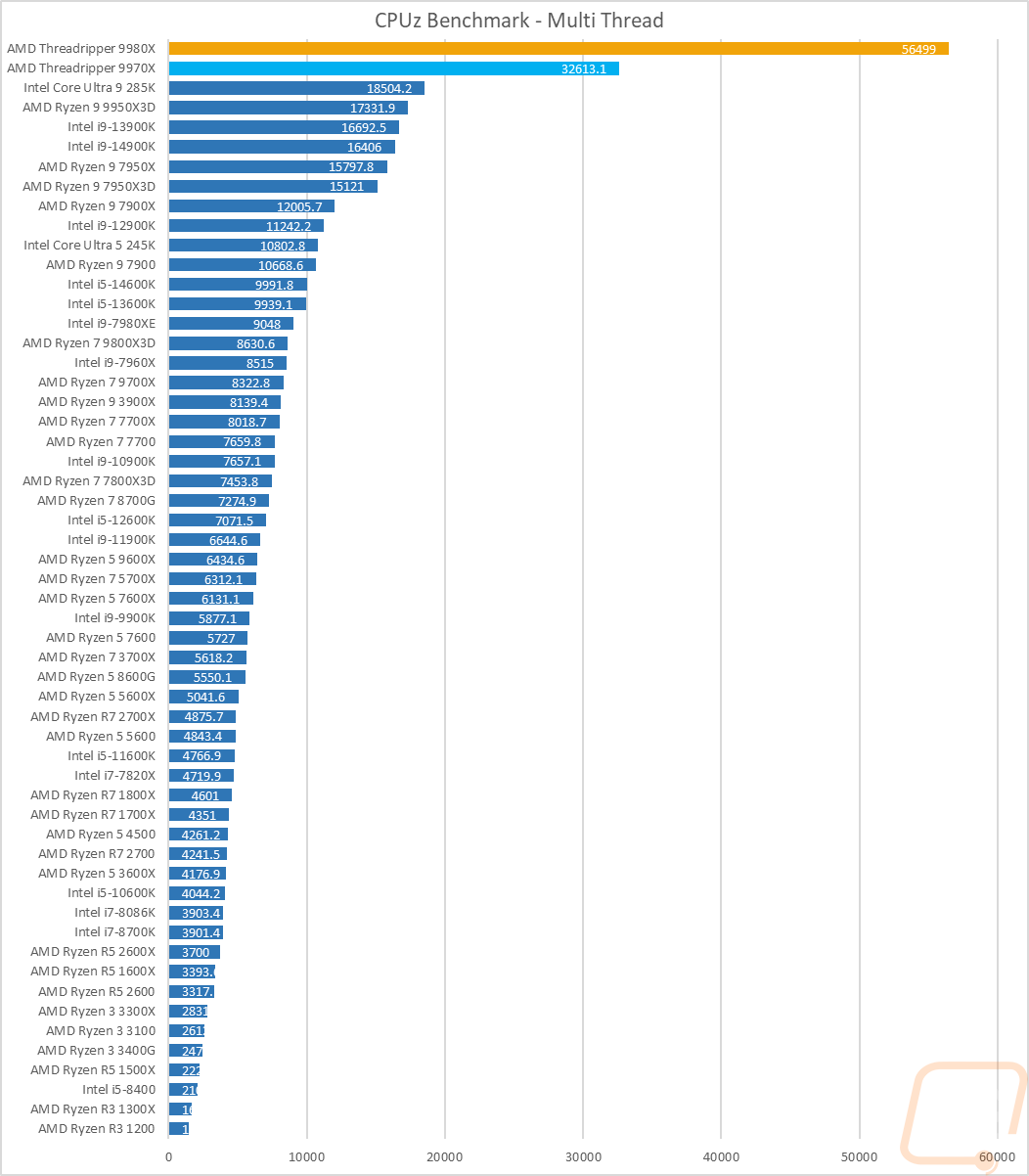
Next, we have wPrime, which is a classic overclocking benchmark that calculates pi out to 1024 million digits and is timed. This is a benchmark that favors high core count CPUs, which both the 9980X and 9970X benefit from. Both finished the test in just over 15 seconds, nearly half of what the Ryzen 9950X3D did.
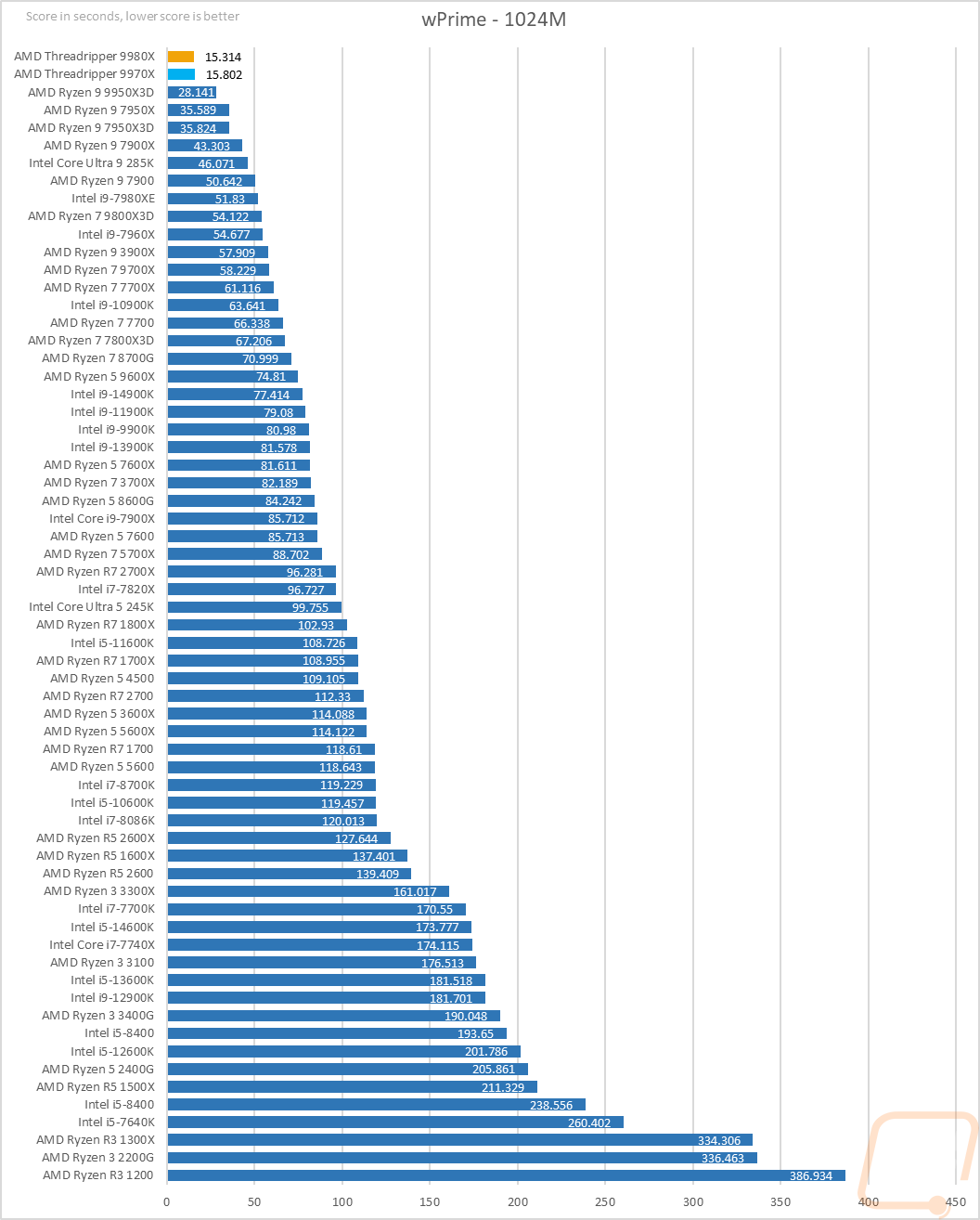
7-Zip is another open-source program, this time for compressing and decompressing all of your files. Here I have run the benchmark, and we have three results. The combined MIPS is a combination of compressing and decompressing performance. Then I have it broken down between the two. The combined results have both the 9980X and 9970X once again dwarfing everything else tested, with scores of 454181 and 691377. IK should note that I had to upgrade 7-Zip to the latest version for testing here, the previous version capped out at 64 threads, which was fine with the 9970X but limited the 9980X by half. With the new Threadripper version of 7-Zip, the 9980X is way out in front, both making everything else tested look slow. The same goes for the individual decompressing and compressing results, but the decompressing with the 9980X out in front.
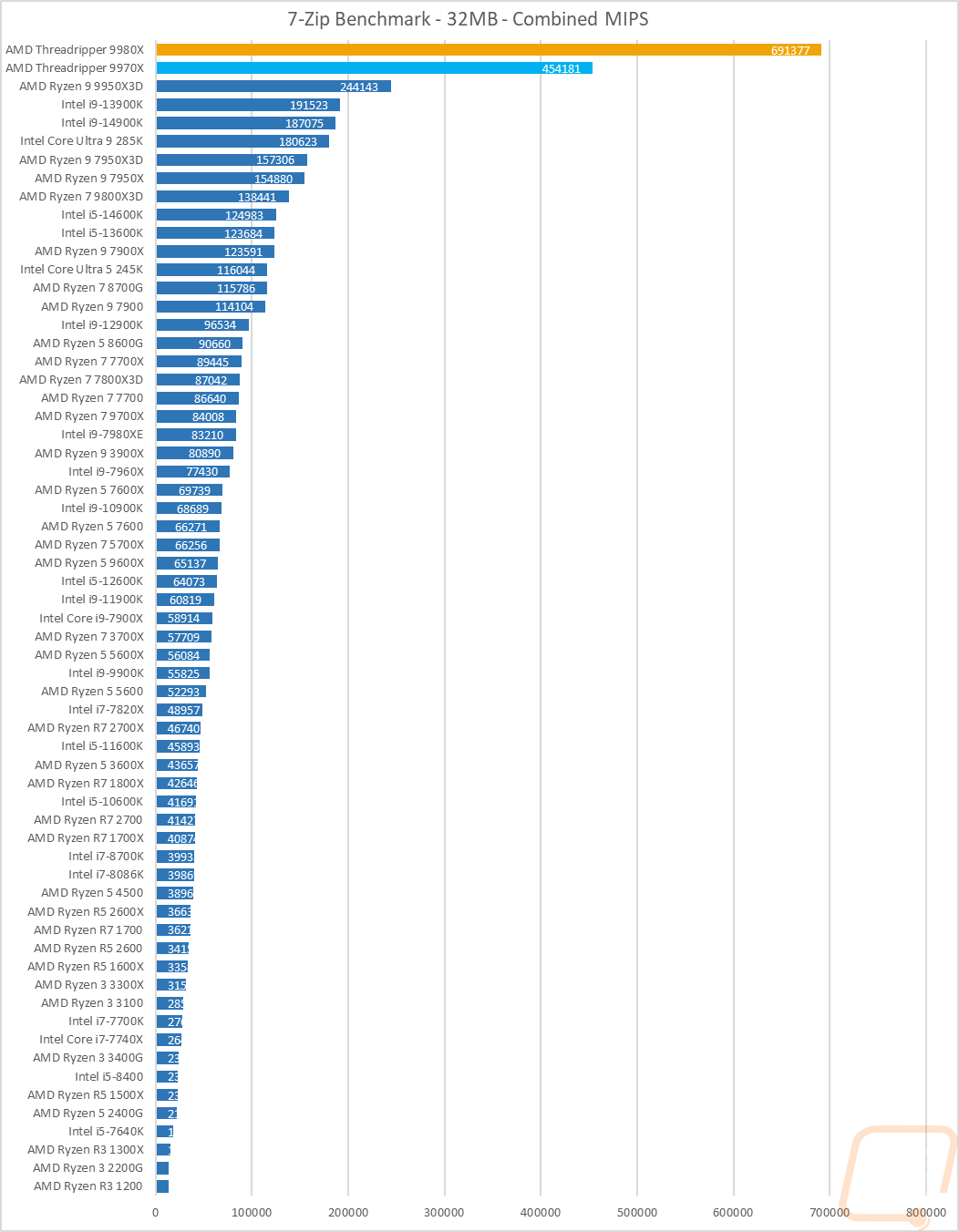
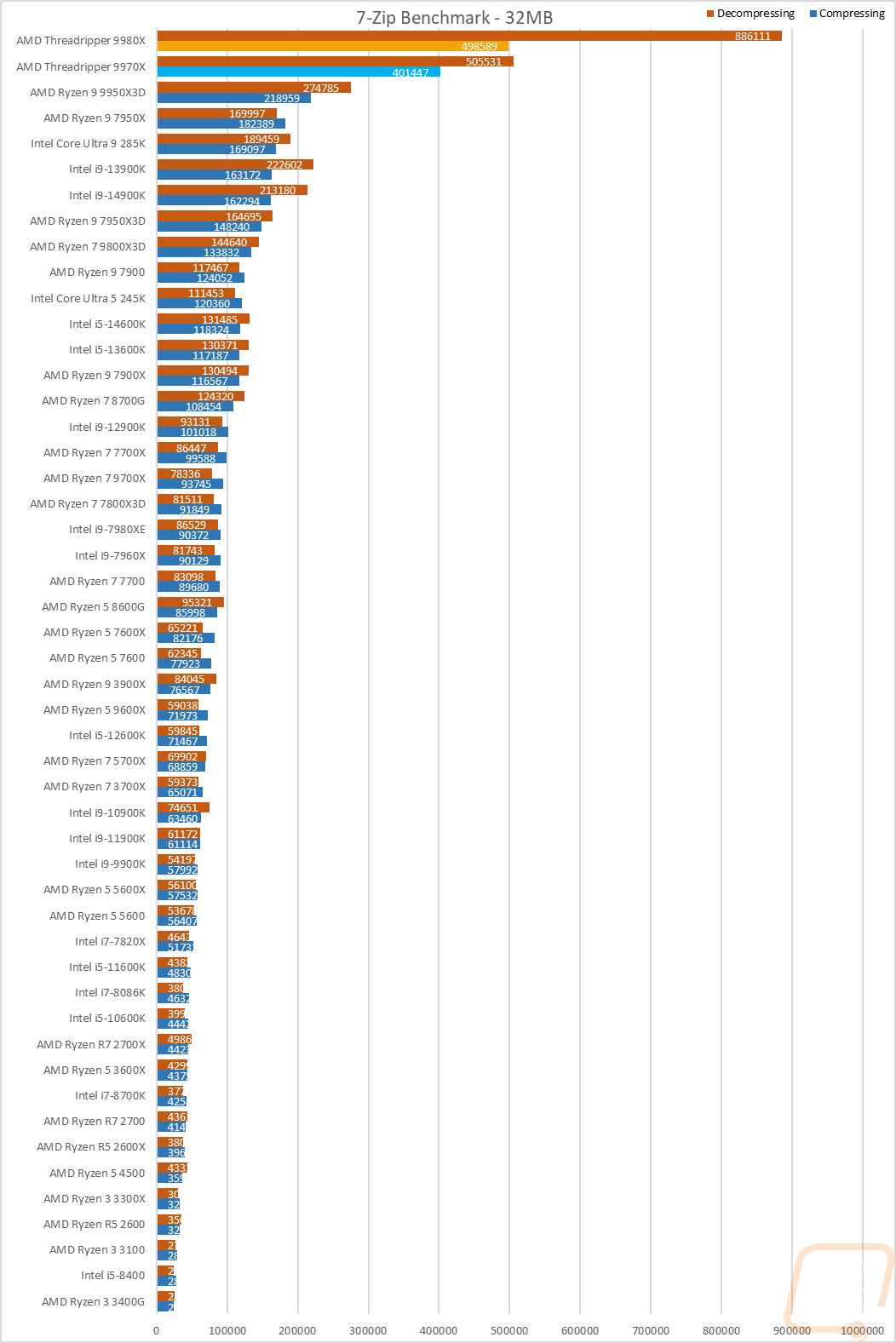
Jetstream 2.1 is a compilation benchmark that takes a long list of HTML5 and Java in-browser tests and runs them all three times, and puts together an overall score. I love this benchmark because let's be honest, most people are using their browser more than any other game or program. Jetstream gives some interesting results sometimes, though, but it tends to prefer high IPC or single-core performance, and there are some situations where it prefers lower core-count CPUs. In this case, both of the Threadripper CPUs did top the charts with both Jetstream 2.1 and 2.2, however, the higher base clock speed for the 9970X did put it out in front slightly. What is surprising, however, is that both tests still show both Threadripper CPUs with a good gap between them and the other CPUs tested.
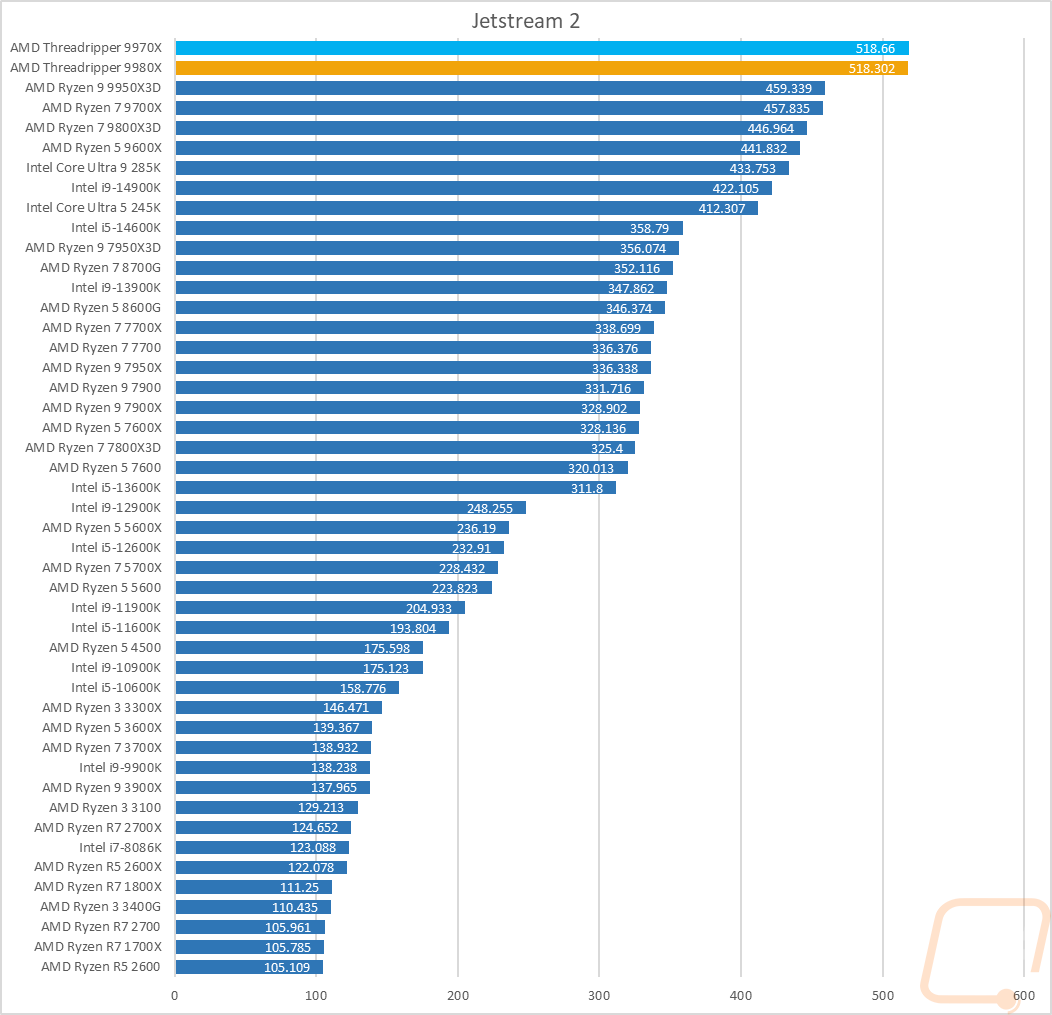

As a new addition to our testing, I have added a few AI-focused tests using Geekbench AI and Procyon’s Computer Vision Benchmark. The Geekbench AI test looks at single and half-precision performance with scores for each and a quantized score as well. They test using 10 different workloads to create their score. The Procyon AI Computer Vision Benchmark focuses on machine vision tests using neural network models like MobileNet V3, Inception V4, YOLO v3, DeepLab V3, Real-ESRGAN, and ResNet 50. I test those using the Windows ML setting, and in cases that support it, I test built-in NPUs as well. I have also included Windows ML and TensorRT results using an RTX 4090, as well as a reference point where these CPUs compare to a high-end GPU. For Geekbench AI, the Threadripper 9970X is up near the top of the chart for its quanitized score, and its single and half precision scores are at the top of the chart. The 9980X, on the other hand, struggled here for unknown reasons on all three tests. Procyon was similar in results with the 9970X at the top of the chart for the CPUs tested, and the 9980X down a little lower in with the 9950X3D and the 285K.
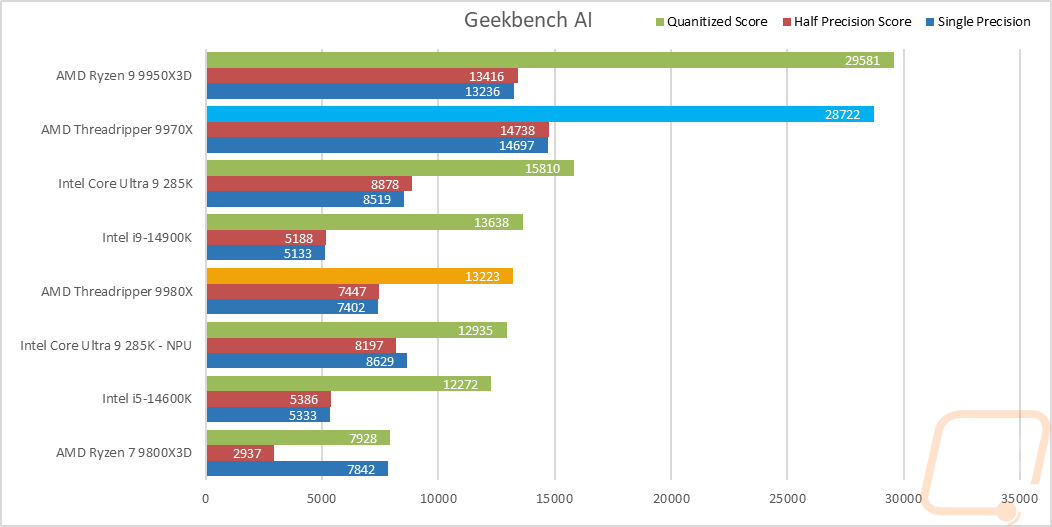

For Passmark Performance Test, I used the latest version, Performance Test 11. I only look at the overall CPU score, which takes a few different synthetic benchmarks and combines the results to put together an overall score. This is a test that favors multi-threaded performance over IPC. In Performance Test 11, both the Threadripper 9980X and 9970X did really well with scores of 146741 and 109121. The 9980X doubled the score of the 9950X3D, which is the next fastest CPU tested.
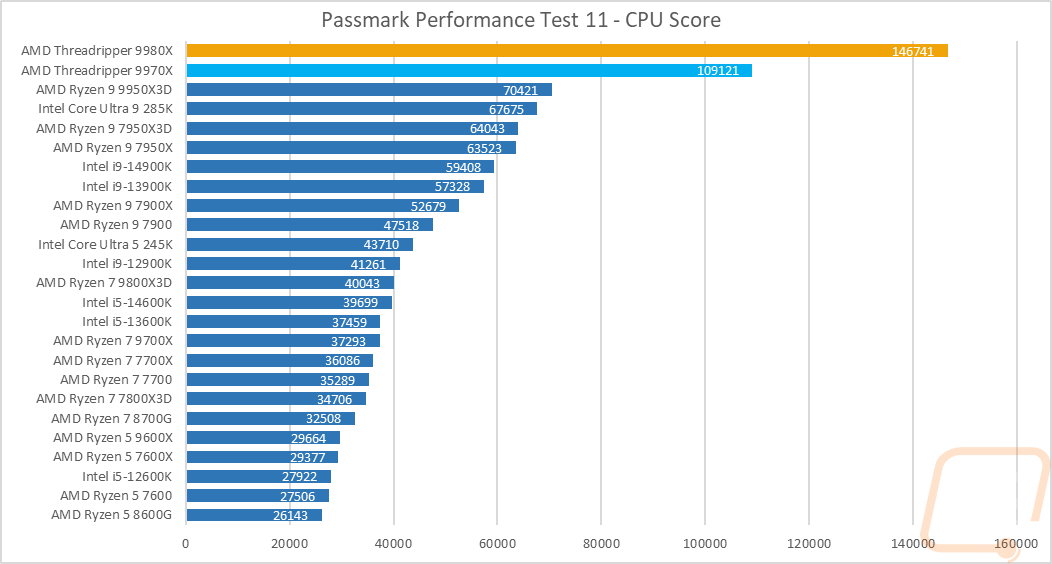
Crossmark is from BAPCo, which also makes SYSmark, and this is a cross-platform test where you can compare performance between phones and both Windows and Mac computers. This is the start of our overall PC benchmarks, and Crossmark uses a mix of real-world tests to output an overall score. The 9980X and 9970X are at the top of the chart here once again, but the 9970X is ahead of the 9980X, and both aren’t far ahead of the 285K. Both of those things let us know that this benchmark isn’t fully utilizing the high core counts.
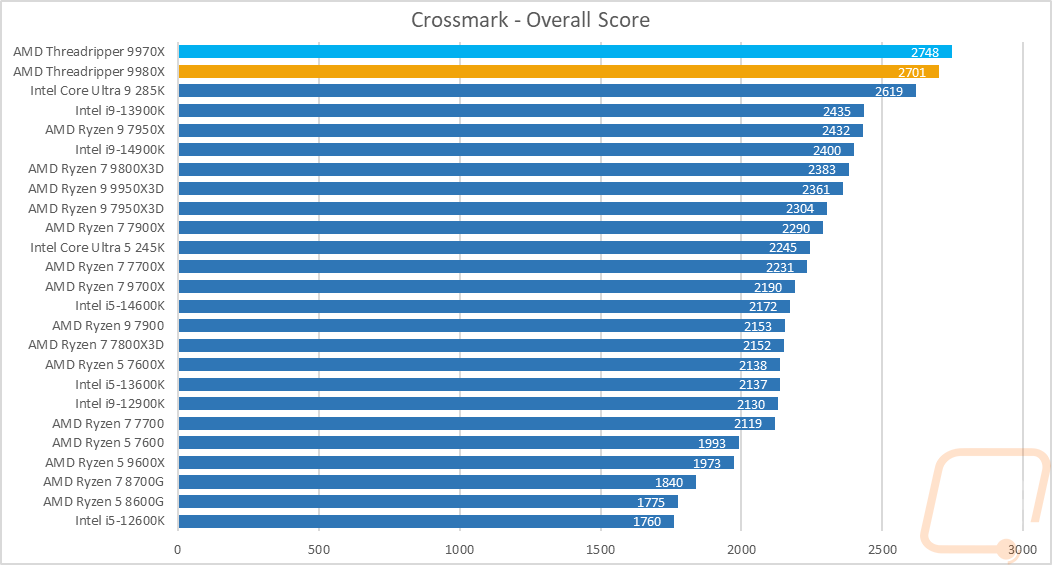
PCMark 10 is a great test because it tests things like video calls, browser performance, Excel, and Word performance to give an idea of real-world performance. It tends to like higher clock speeds, but does take raw core count into account as well, which you can see. The 9980X and 9970X aren’t at the top of this test, it favors clock speed over core count, and you can see that with CPUs like the 9950X3D sitting out in front. For the PCmark 10 applications test, both CPUs do jump back out in front, but even then, the 9970X is on top here, telling us once again that these were limited in thread count and didn’t utilize the 9980X’s twice as many cores.
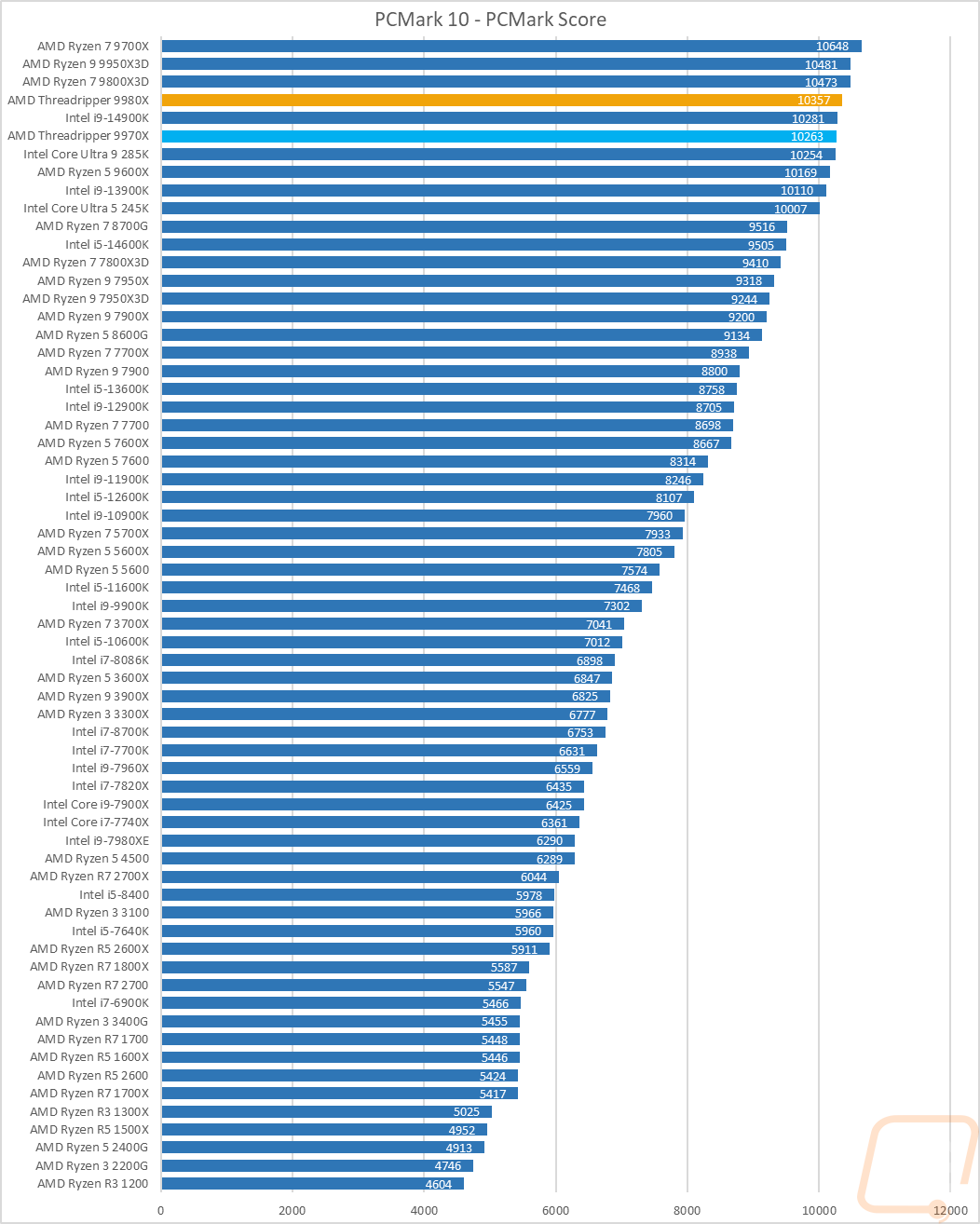

For our last real-world (non-gaming) benchmark, I ran both Photoshop and DaVinci Resolve tests using the PugetBench for Creators benchmark. This gives us a great look at real-world performance using the latest version of both popular programs, which I personally use as well for editing photos and videos. With DaVinci Resolve, the 9980X tops the chart by a good margin, and the 9970X comes in behind it. That same performance isn’t seen with Photoshop, however, with the 9980X coming in behind not just the 9970X, but also the 9950X3D and the 14900K as well. Clearly, it isn’t taking advantage of all 64 cores.

Moving the focus over towards gaming, my next test is using Dolphin 5.0 Benchmark. Dolphin 5.0 is a Wii emulator, and like most emulators, it doesn’t care about high core counts much. Clock speeds are king here most of the time, which is why all of the 5 GHz+ CPUs are at the top of the chart here. The 9980X did still manage to top this chart, utilizing its 5.4 GHz max clock speed, matching the 9950X3D with the 9970X just behind it.
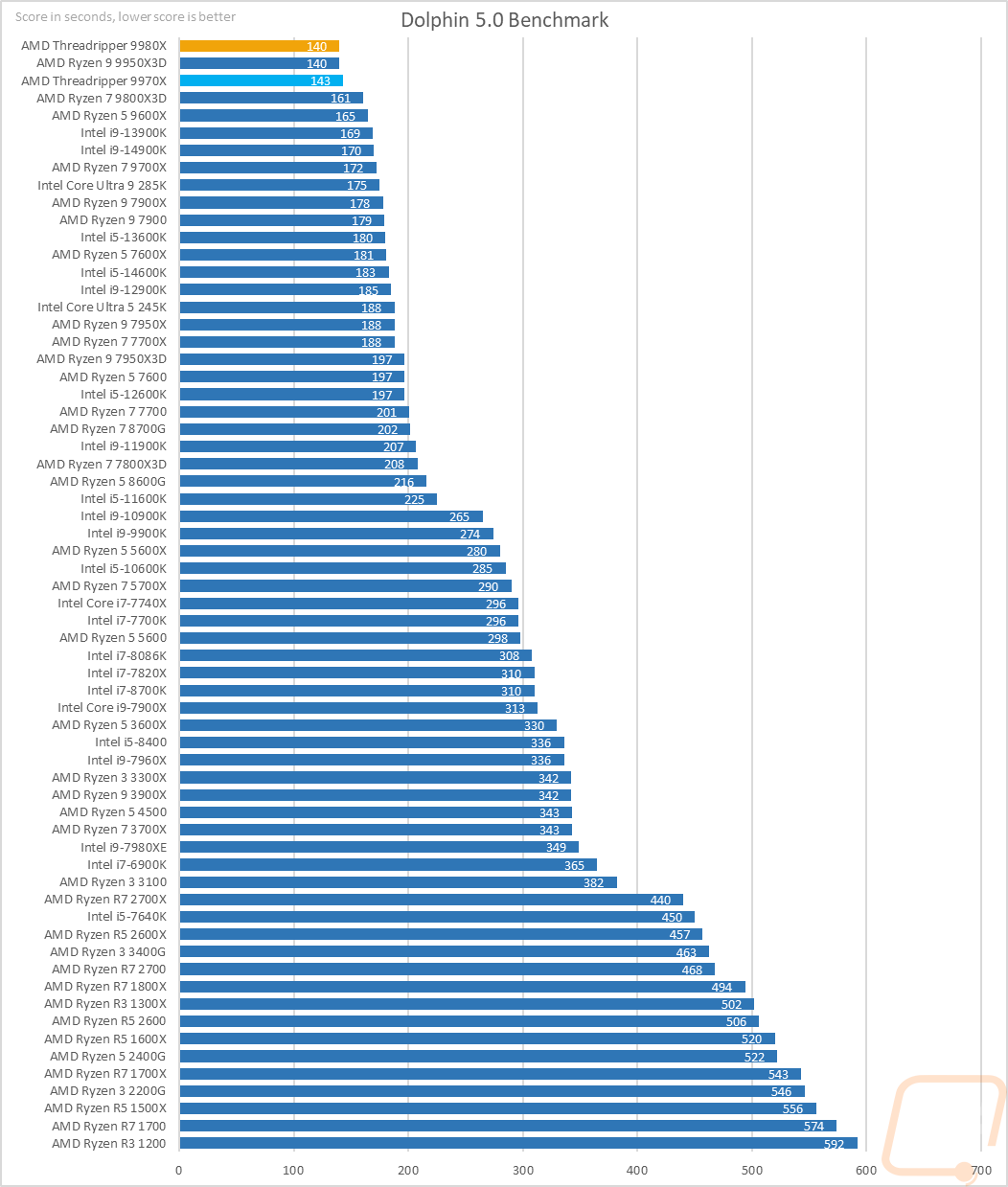
Before diving into game testing, I wanted to check out synthetic performance using 3DMark. I tested with the older DX11 Fire Strike test as well as the newer DX12 Time Spy. I also added the new 3DMark CPU Profile benchmark into the mix as well which does a good job of showing the full range of thread counts that you might see being used in games, as well as a max threads option that does everything above 16 threads. In both the Fire Strike and Time Spy tests, both the 9980X and 9970X show up in the middle of the pack. Let me be clear, these are not gaming CPUs by any measure. With the 9970X coming in ahead of the 9980X, we know 3DMark isn’t utilizing the 64 cores of the 9970X, but that isn’t any different than any other game. I’ve just included these tests as well, even though these CPUs aren’t meant for gaming, so anyone who might be interested in using their new Threadripper build for both creating and gaming. Now the 3DMark CPU profile does put all of the threads to use, and we can see that in the max threads portion of that benchmark. The 9970X was at the top of the chart when limited to 16 threads, but both jumped way up for that last result with the 9980X, of course, on top by an impressive 7000 points.
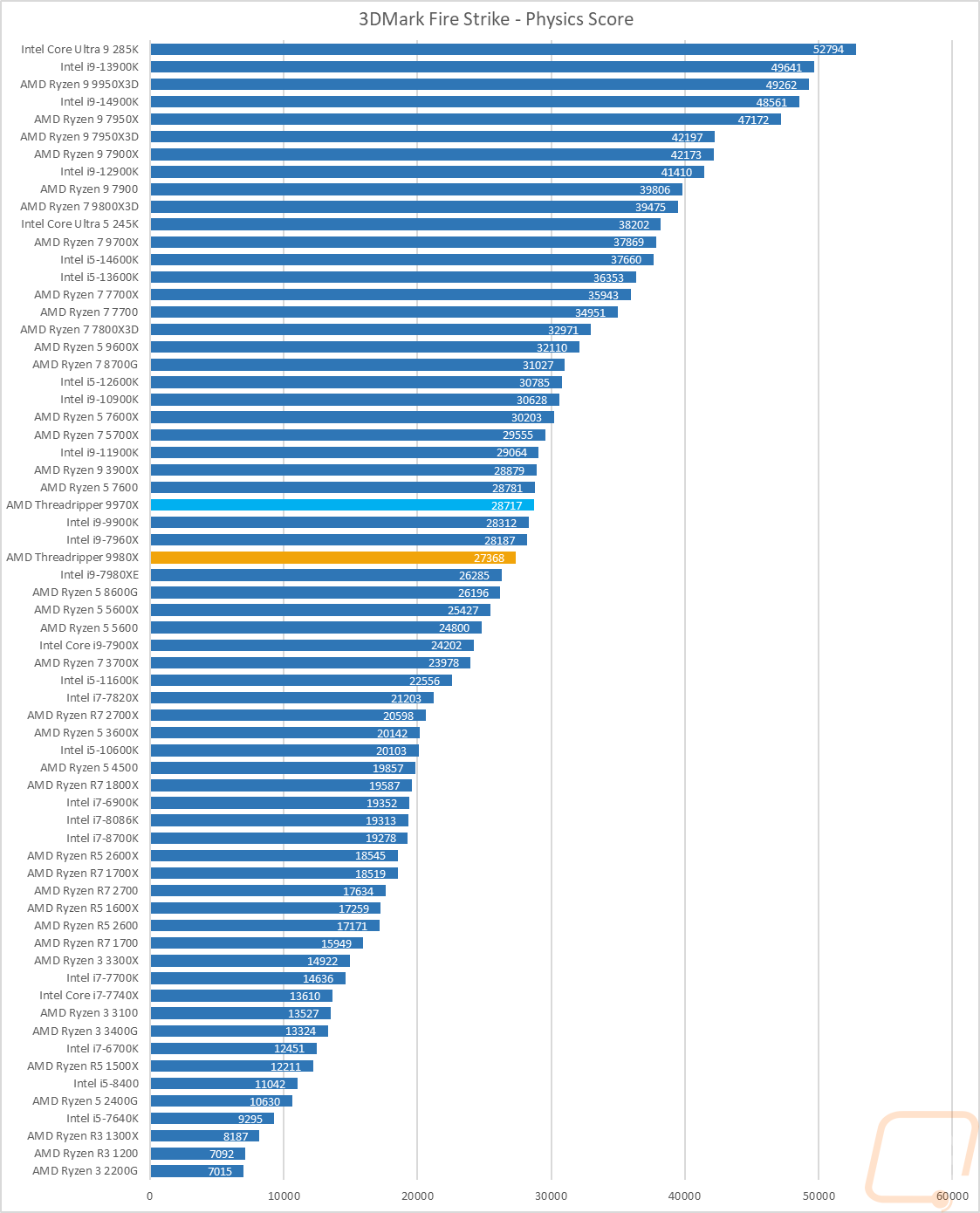
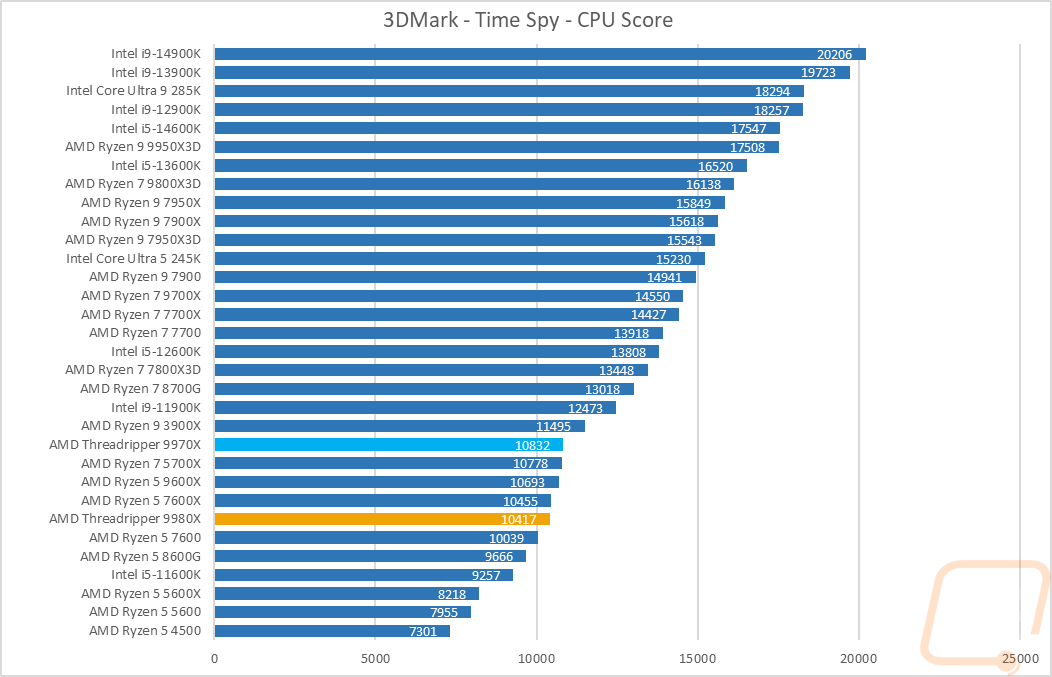
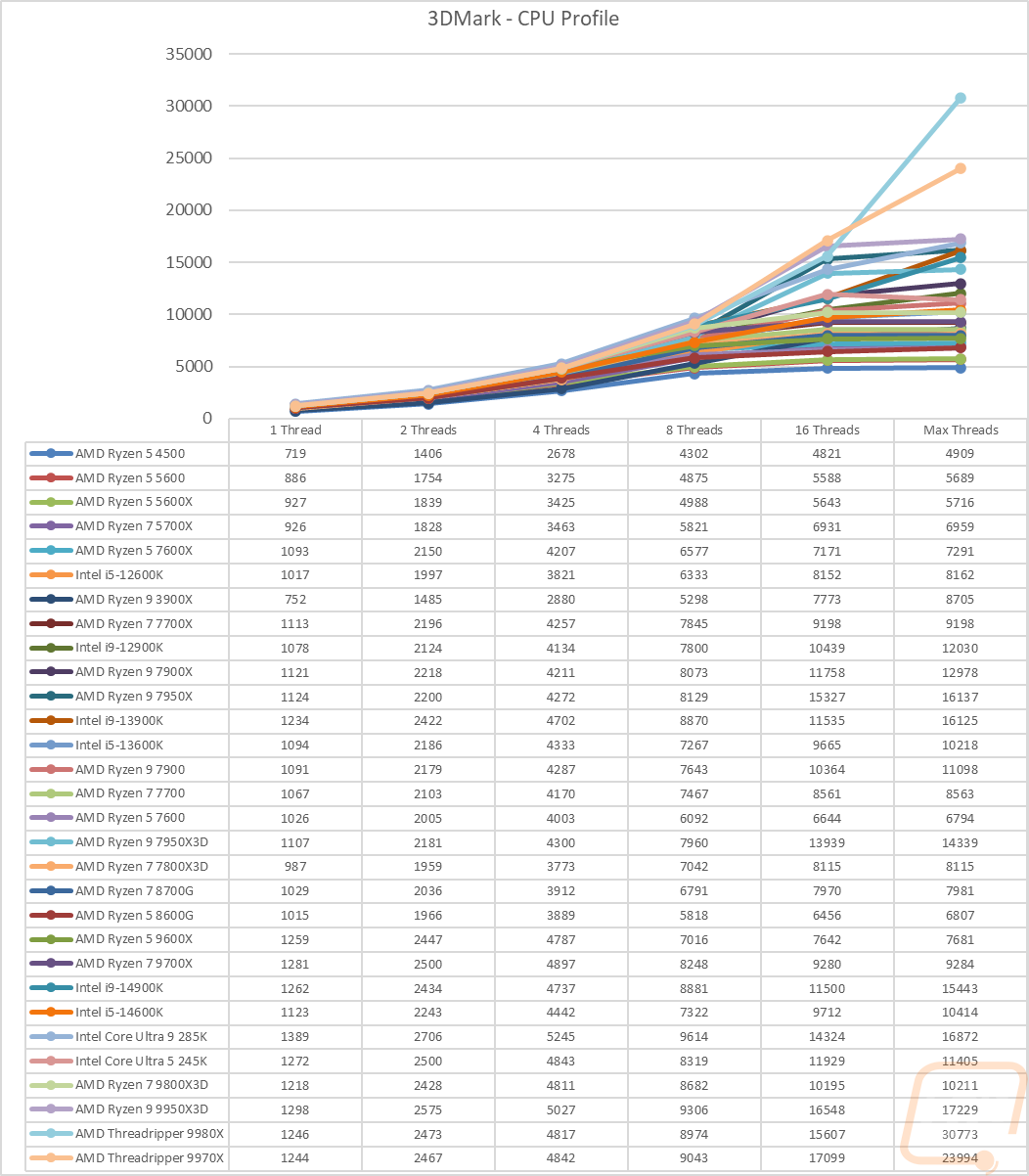
I did, of course, test the two new CPUs in games as well. I said it in the previous test, but I will say it again here. These Threadripper CPUs aren’t designed for gaming. If that is your only goal, then one of the X3D CPUs is still going to be your best option. But they did still hold their own overall. They came in behind all of the X3D CPUs in everything except the Wildlands Breakpoint. But in some of the games, they do still run with CPUs like the 14900K and 285K. There are a few games where both CPUs drop down into the middle of the charts, however. Overall, though, even middle of the pack is still great gaming performance if you are able to also get crazy performance in your work applications.
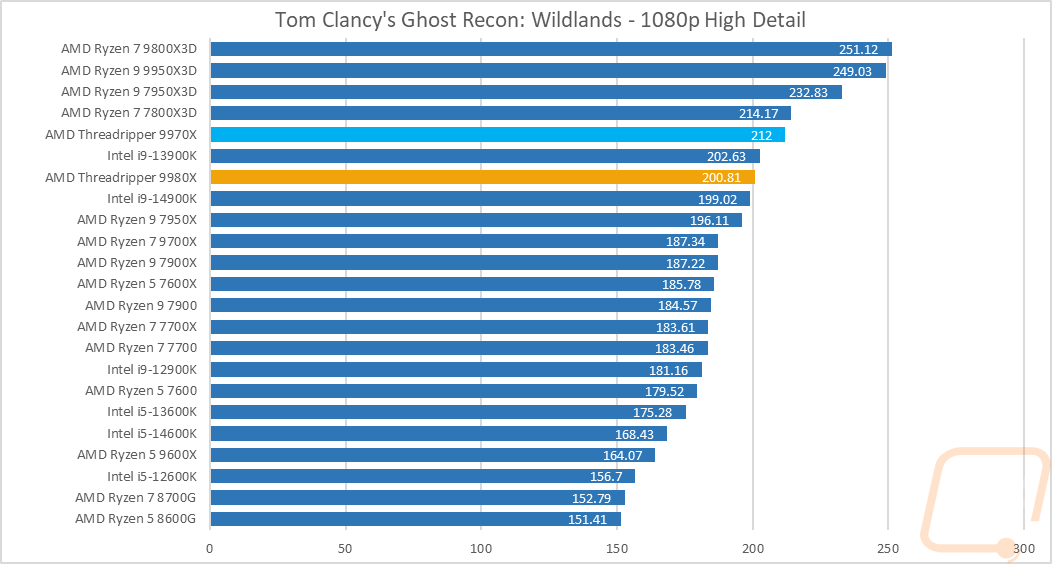

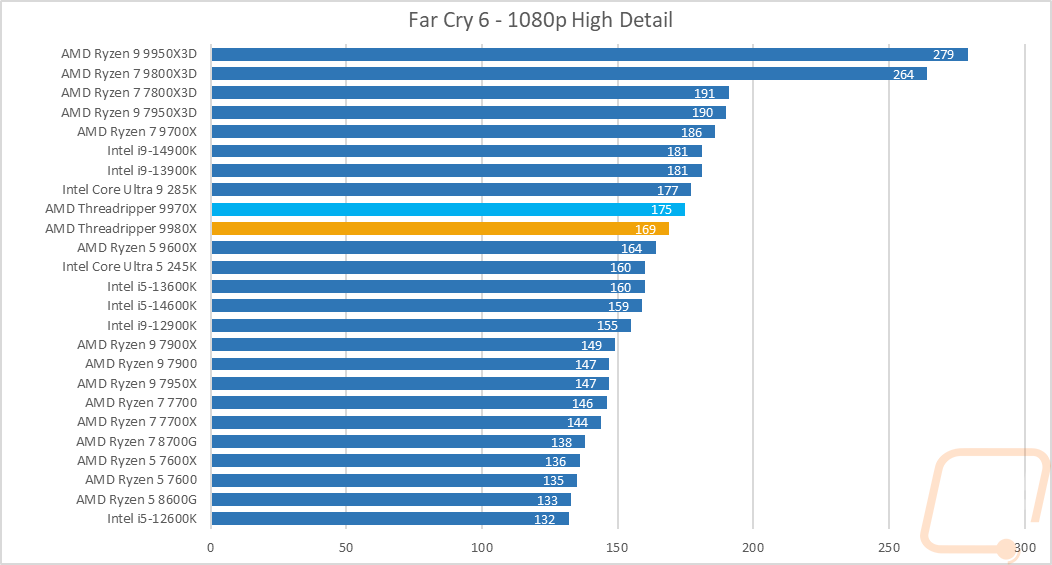
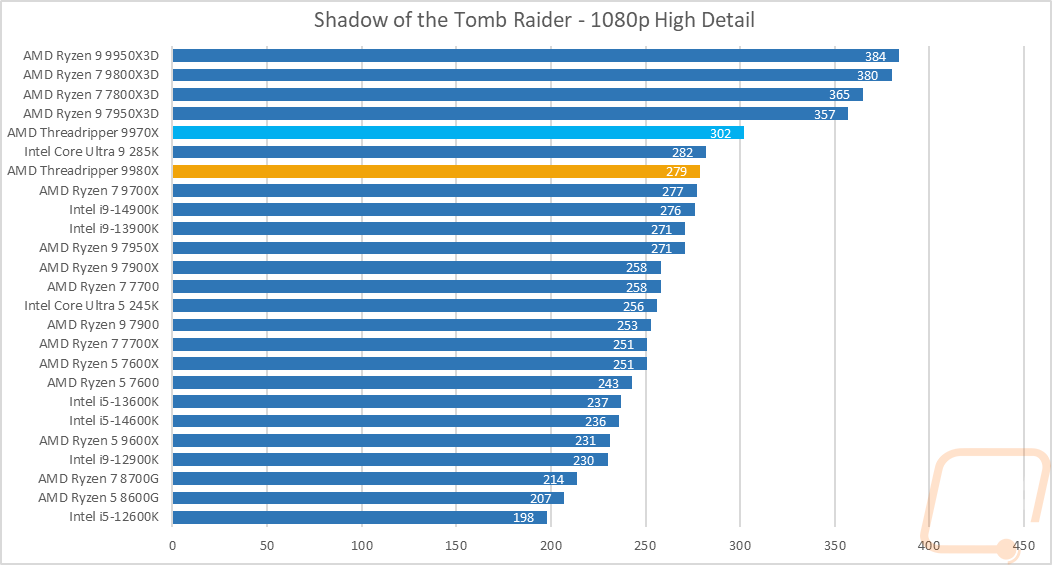
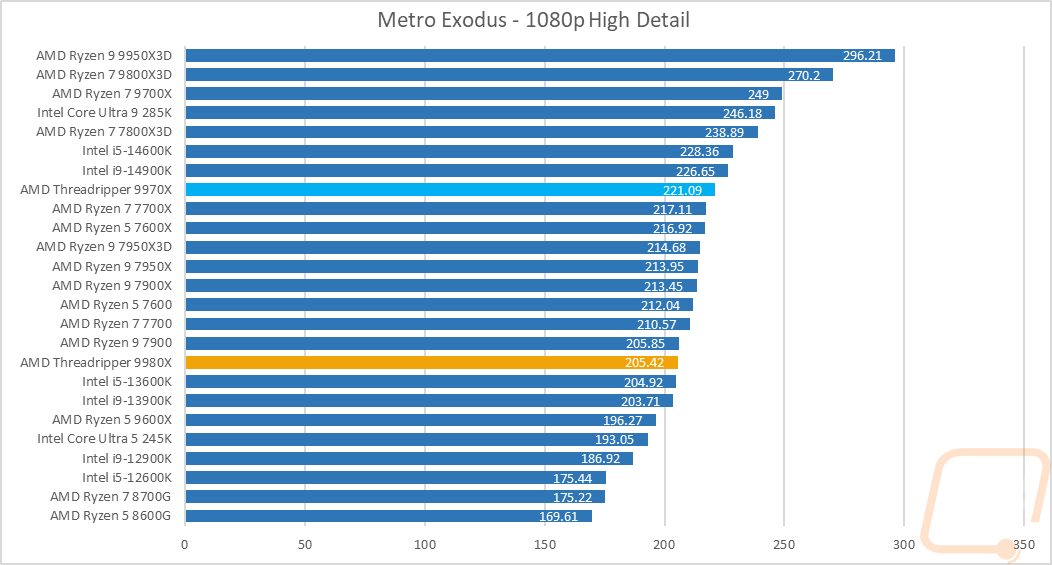
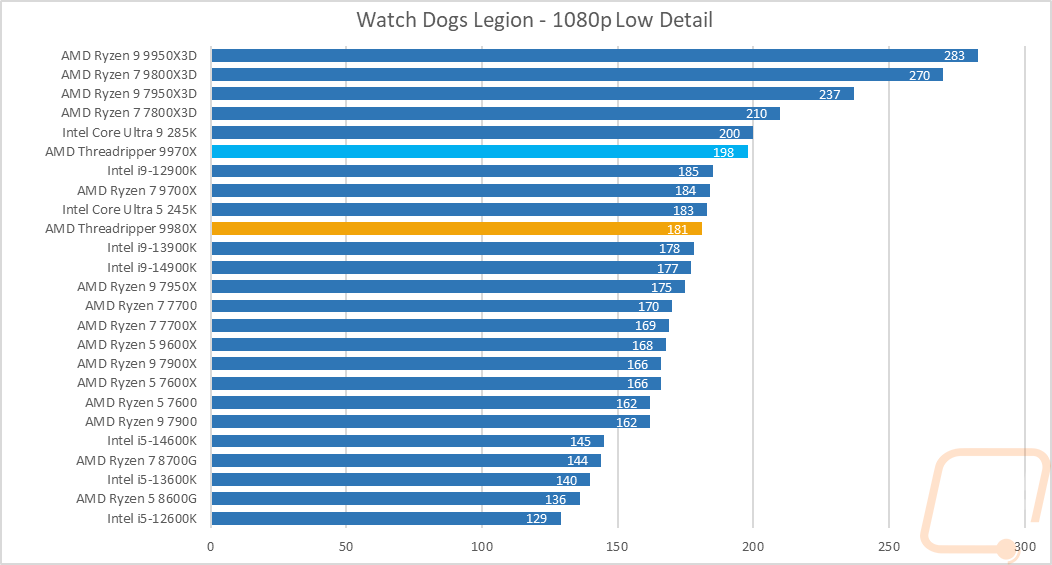
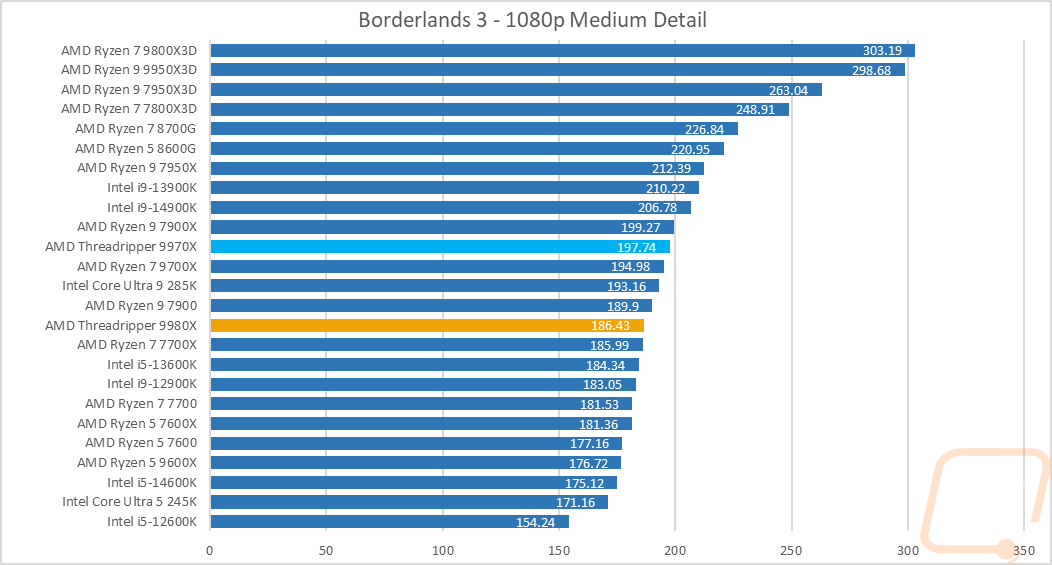

Lastly, I also run the AIDA64 benchmarks as well. These give us a great look at a few aspects, including the full range of cache performance, memory performance, and more. The numbers that stood out for me were the L1, L2, and L3 cache performance for both CPUs (especially the 9980X), with the L2 numbers dwarfing the previously impressive numbers from the 990X3D. Going to quad-channel memory, especially at 6400 MHz, was more than double the improvement on the memory read and write performance, but latency did increase there. Single and Double Precision FLOPS were more than triple that of the 9950X3D, and the same goes for the Integer IOPS numbers as well.
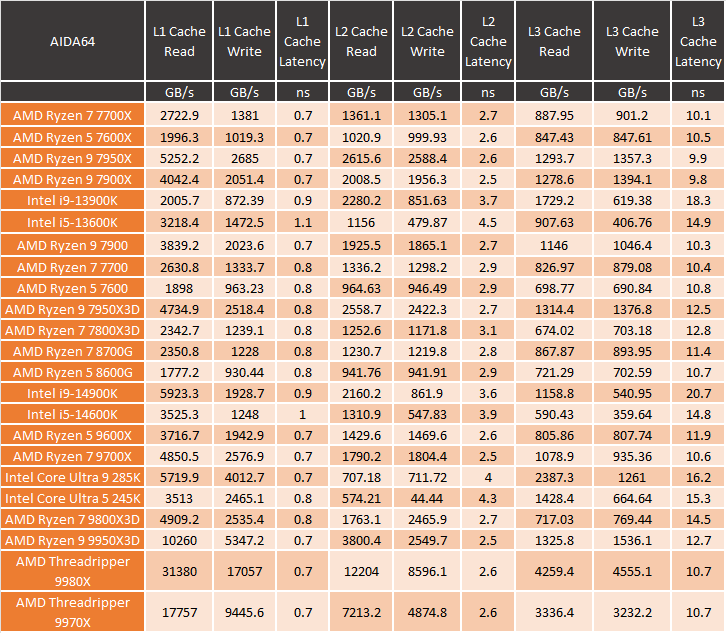
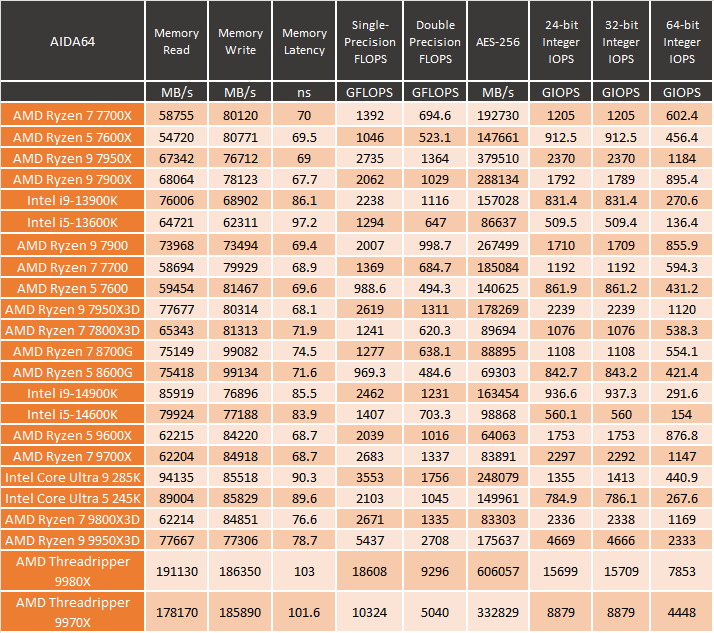
Power Usage and Temperatures
For some people, performance is the only thing important, but for others, power usage and temperatures also play a role, so we do take a look at both of those as well. This is especially important in SFF or even just smaller mid-sized builds, and it affects the components you need to get for your system as well as your PSU and cooler (not really an issue here obviously). To take a look at power usage, I ran three different tests. I noted the idle power draw of our entire system, then I took a look at the load wattage of the system using two different workloads. One was wPrime, and the second was AIDA64 using their FPU workload, which is extremely demanding. At idle, the testbench with the Threadripper 9980X pulled 140 watts, where the 9970X pulled 128 watts, both were higher than what I see from the mainstream line, but nothing too crazy. Putting things under load, on the other hand, you can quickly see how both CPUs are pulling a lot more than a 9950X3D, for example. With wPrime putting things under load, the 9970X pulled 499 watts, and the 9980X pulled 534 watts. Our AID64 numbers get a little weird, however. This is another case where the CPU overshoots the benchmark, and our 9980X wasn’t able to get under full load using the FPU Stress Test, so it “only” pulled 451 watts to the 504 from the 9970X.
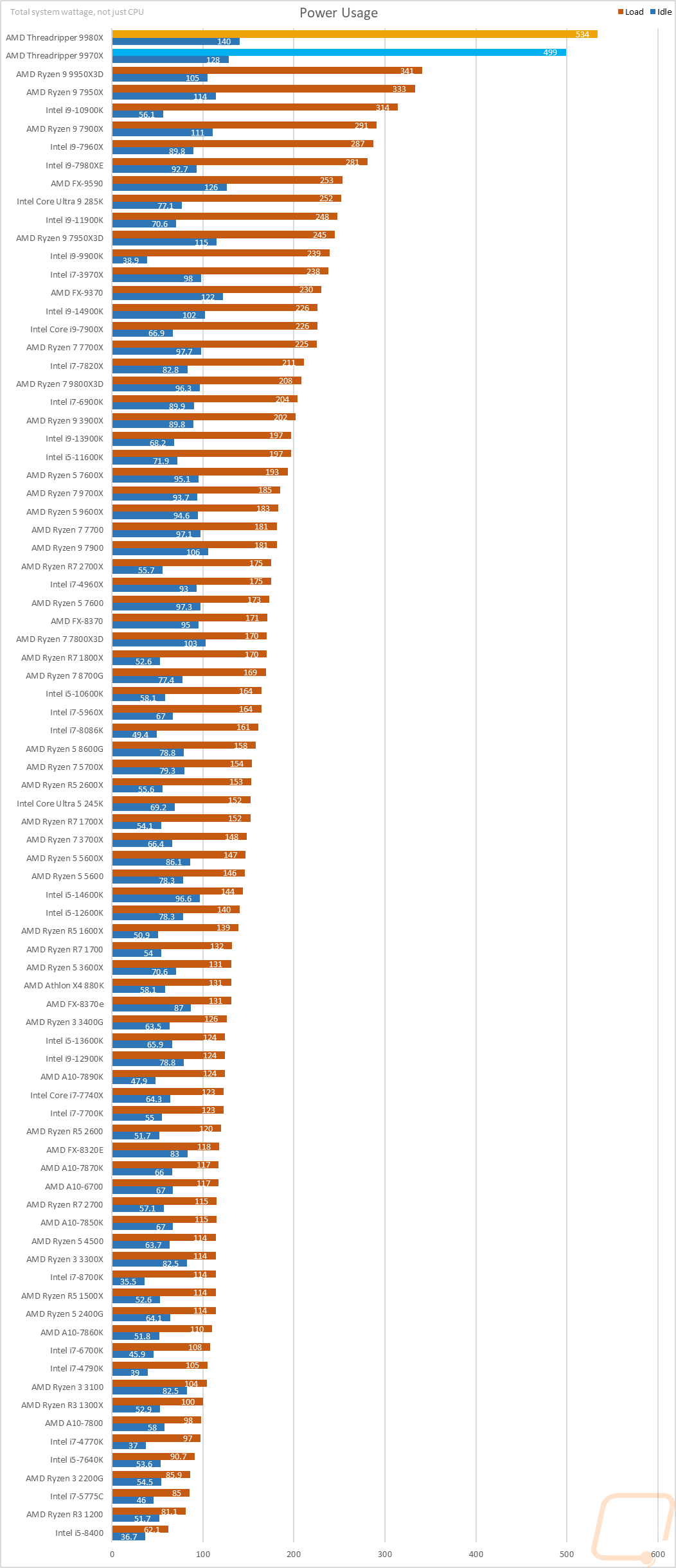
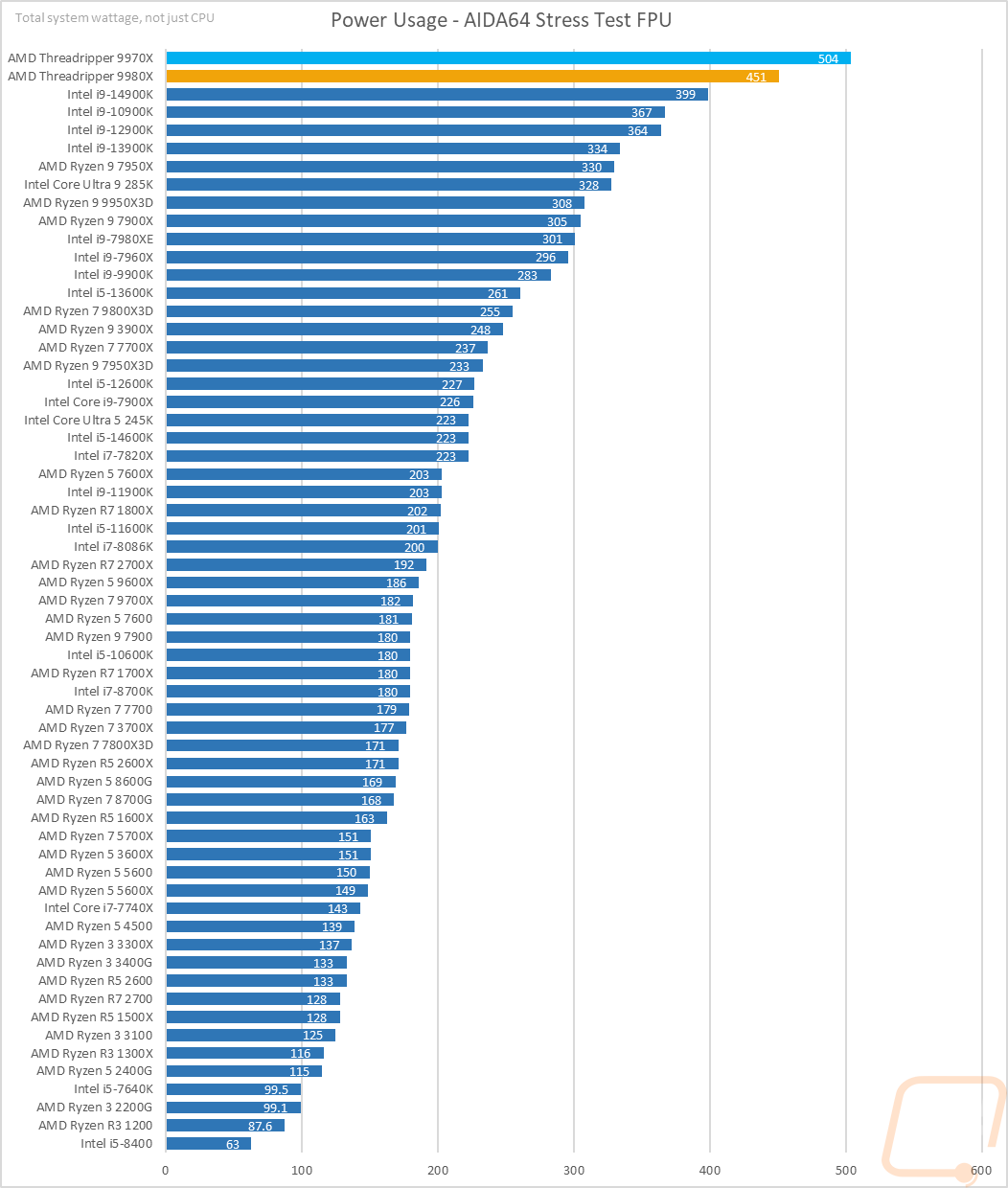
The issues with AIDA64 carried over to our temperature testing as well, because that is how we put everything under load for temperature testing. At least the AIDA64 Stress Test CPU workload worked, so those numbers are correct. The other factor here is what numbers we want to go off of. Threadripper is a huge CPU, and we have three temperature numbers that we can work from. There is CPU, CPU Diode, and CPU package. The CPU number is the temperature on the CPU socket from the motherboard, I’m not worried about that number here. Then we have CPU package and the Diode. The CPU Package shows the whole CPU, but the diode shows us how hot things are getting right at the die. My graph numbers are all using the CPU package, but I should note the diode numbers were crazy with the 9980X sitting at 126c °C and the 9970X at 129c °C. In the end, our CPU workload results are the main focus as they were under full load, and the 9980X leveled off at 77c where the 9970X was at 79c °C. For comparison, the 9950X3D was at 70c with a similarly sized cooler. But these are extremely powerful CPUs, which frankly, an even larger cooler than the 360mm AIO that AMD sent over wouldn’t be a bad idea.
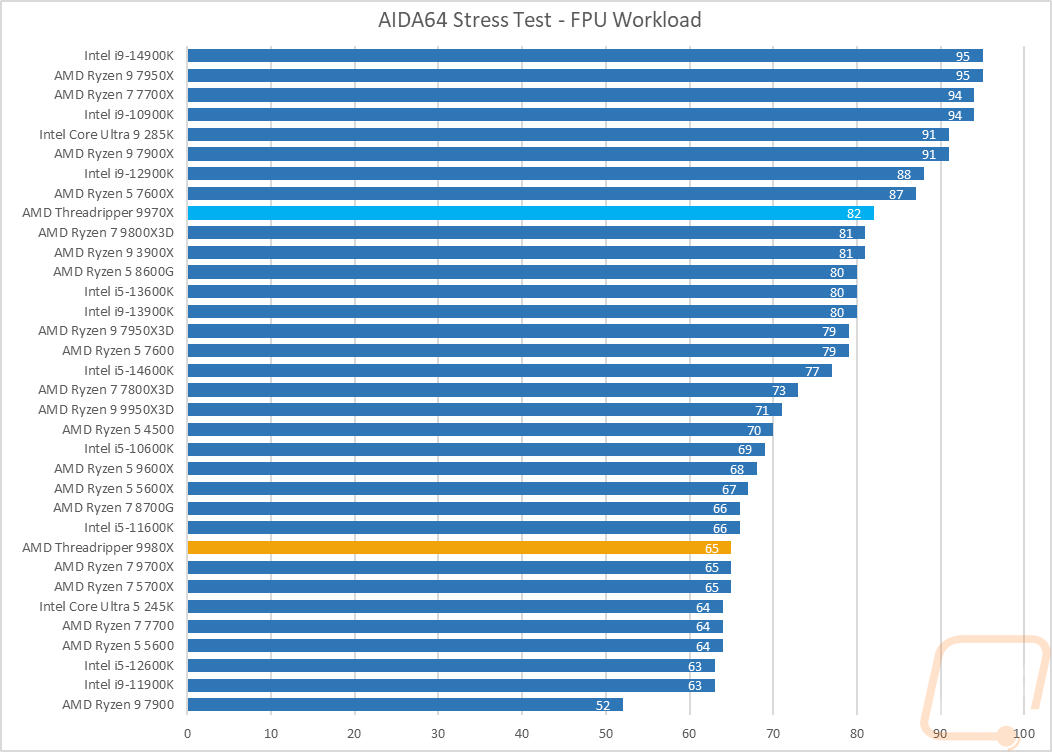

Overall and Final Verdict
When you want the biggest and best PC build, there isn’t just one solution that is going to cover everything. AMD recognizes that, and you can see that even just in their mainstream CPU lineup with a wide range of options, even before mixing in their X3D lineup as well. That is exactly why they have their Threadripper lineup sitting in between the top of their regular Ryzen lineup and below the Threadripper Pro line. Their new 9000 Series Threadripper CPUs refresh what they had previously with the Threadripper 7000 Series CPUs, but with Zen 5 architecture, a bump in max clock speeds, more PCIe 5.0 lanes, and faster memory support as well. The best part is that they are still utilizing the same chipset and socket as the previous generation. In fact, all three CPUs slot in at the same price points and with the same core/thread counts as before. So if you already had a Threadripper build and were considering an upgrade, these will work. The flagship of this lineup is the Threadripper 9980X with 64 cores and 128 threads. It dominated in all of the benchmarks we put it through that could handle that high of a thread count. There were some situations where having twice as many cores as the 9970X wasn’t utilized, and in those specific situations, the higher base clock speed of the 9970X helped it stand out. That said, which CPU is ideal for you depends entirely on how you are using it. In the tests that could handle the 9980X, it dwarfed the rest of the CPUs tested, including the 9950X3D, which is a monster in its own right.
Both the 9980X and 9970X do have a few downsides, the biggest, of course, is going to be just how much power you need to push this kind of power. CPU power demands have been growing quickly over the years, but these push things to their limits. Which should be no surprise given their performance, but the motherboards were ready, with our Asus board also supporting dual power supplies to make sure power needs were covered. All of that power means a lot of heat, and because of the large CPU size, you will also need a Threadripper-specific cooler. Well, the CPUs do come with an adapter for Asetek AIO water coolers, but I myself would prefer having a cooler with a full-sized contact surface that can handle the Threadripper CPU size, and you want to go with the biggest cooler you can get.
Both the Threadripper 9980X and the 9970X are monsters, dominating any test that could fully take advantage of them, there is no question there. But how much does it all cost? Well, if you normally are shopping in the mainstream CPU market, these prices will come as a surprise. The 9980X has an MSRP of $4999, and the 9970X is $2499. Those are crazy prices for sure, but normally to get CPUs like this you need to go with server CPUs or the Threadripper Pro lineup, both of which have prices that make the 9980X and 9970X pricing look like a value, and the truth is, for those customers it is. If you don’t need the Pro-specific features or 8-channel memory, you can save money by going with a TRX50 motherboard and a new 9000 Series Threadripper CPU. All I know is that with these hitting the market, there are going to be some new monster systems built, and I’m all for that. I just hope you and the application you are planning on using it with are ready for all of that power!
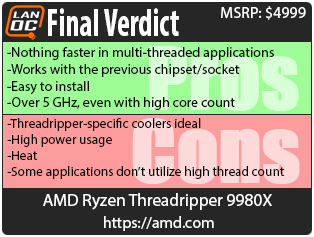

Live Pricing: AMD Ryzen Threadripper 9980X
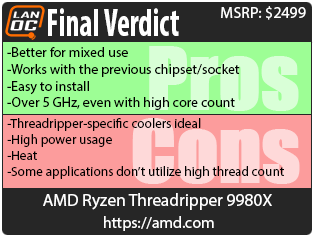
Live Pricing: AMD Ryzen Threadripper 9970X

